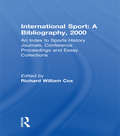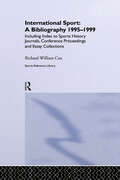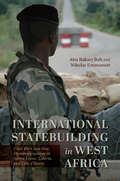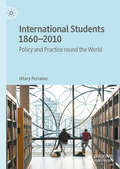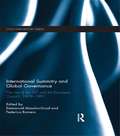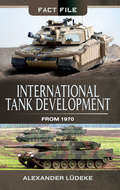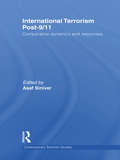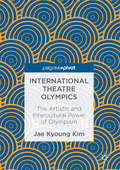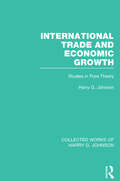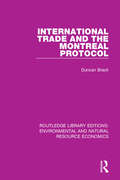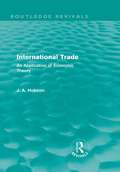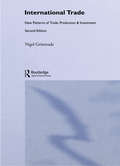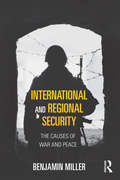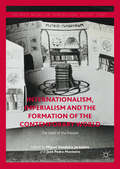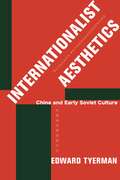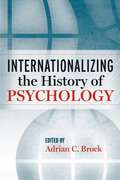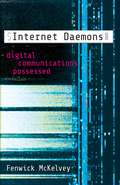- Table View
- List View
International Sport: An Index to Sports History Journals, Conference Proceedings and Essay Collections
by Richard William CoxThere has been an explosion in the quantity of sports history literature published in recent years, making it increasingly difficult to keep abreast of developments. The annual number of publications has increased from around 250 to 1,000 a year over the last decade. This is due in part to the fact that during the late 1980s and 90s, many clubs, leagues and governing bodies of sport have celebrated their centenaries and produced histories to mark this occasion and commemorate their achievements. It is also the result of the growing popularity and realisation of the importance of sport history research within academe. This international bibliography of books, articles, conference proceedings and essays in the English language is a one-stop for the sports historian to know what is new.
International Sport: Including Index to Sports History Journals, Conference Proceedings and Essay Collections.
by Richard William CoxThere has been an explosion in the quantity of sports history literature published in recent years, making it increasingly difficult to keep abreast of developments. The annual number of publications has increased from around 250 to 1,000 a year over the last decade. This is due in part to the fact that during the late 1980s and 90s, many clubs, leagues and governing bodies of sport have celebrated their centenaries and produced histories to mark this occasion and commemorate their achievements. It is also the result of the growing popularity and realisation of the importance of sport history research within academe. This international bibliography of books, articles, conference proceedings and essays in the English language is a one-stop for the sports historian to know what is new.
International Statebuilding in West Africa: Civil Wars and New Humanitarianism in Sierra Leone, Liberia, and Côte d'Ivoire
by Abu Bakarr Bah Nikolas EmmanuelAt the turn of the twenty-first century, manipulation of the democratic process coupled with preexisting political and economic grievances led to years-long civil wars in Sierra Leone, Liberia, and Côte d'Ivoire. During and after these conflicts, international peacekeeping efforts and humanitarian intervention became the dominant paths for restoring stability by rebuilding the state. Using these three countries as case studies, this manuscript sheds light on internationally driven state building in war-torn West African nations, the problematic nature of the postcolonial state, and the difficulties of securing its people's wellbeing.Connecting peace and conflict, democracy, and international development studies, Bah and Emmanuel argue that there is a clear nexus between the concepts and practices of peace building and statebuilding; that peace building and statebuilding are not domestic matters alone but also matters of global intervention; and that civil wars can be viewed as opportunities for state building through creative postwar partnerships and organization. This study goes beyond the familiar concepts of failed states, R2P, peacekeeping, and peace mediation and introduces and enhances the concepts of state decay, new humanitarianism, people-centered liberalism, and institutional design. In doing so, it provides critical lessons that local and international actors can draw on as they try to figure out practical solutions to the political, economic, and social problems that impede the development of peaceful and democratic multiethnic postcolonial states in Africa and beyond. Applying comparative-historical methods and theory to archival materials and expert interviews, International Statebuilding in West Africa seeks to shift the discourse on civil wars from their causes and implications to the opportunities they provide to rework failed states—and to shift the discourse on African states from their colonial and neocolonial legacies to their shared moral and security interests with the rest of the world.
International Students 1860–2010: Policy and Practice round the World
by Hilary PerratonThis book describes how the number of international students has grown in 150 years, from 60,000 to nearly 4 million. It examines the policies adopted towards them by institutions and governments round the world, exploring who travelled, why, and who paid for them. In 1860 most international students travelled within Europe; by 2010 the largest numbers were from Asia. Foreign students have shaped the universities where they studied, been shaped by them, and gone on to change their own lives and societies. Policies for student mobility developed as a function of student demand and of institutional or national interest. At different times they were influenced by the needs of empire, by the cold war, by governments' search for soft power, by labour markets, and by the contribution students made to university finance. Along with university students, others travelled abroad to study: trainee nurses, military officers, the most deprived and the most privileged schoolchildren. All their stories are a vital part of the world's history of education and of its broader social and political history.
International Studies: An Interdisciplinary Approach to Global Issues
by Sheldon Anderson Mark Allen Peterson Stanley W. ToopsThis core text is the first to provide a much-needed interdisciplinary approach to international studies. Emphasizing the interconnected nature of history, geography, anthropology, economics, and political science, International Studies details the methodologies and subject matter of each discipline then applies these discipline lenses to seven regions: Europe; East Asia and the Pacific; South and Central Asia; sub-Saharan Africa; the Middle East and North Africa; Latin America; and North America. This disciplinary and regional combination provides an indispensable, cohesive framework for understanding global issues. The fully updated fourth edition includes four new global issues chapters: The Refugee Crisis in Europe; The Syrian Civil War and the Rise of the Islamic State; Global Climate Change; and The Globalization of Modern Sports.
International Summitry and Global Governance: The rise of the G7 and the European Council, 1974-1991 (Cold War History)
by Federico Romero Emmanuel Mourlon-DruolThis volume is the first detailed study of the emergence of regular and frequent heads of government meetings (summits), covering the period from the mid-1970s to the early 1990s. Summit meetings of heads of government have become 'banal' in today's world. Yet they are a relatively recent practice that took off only in the mid-1970s. The aim of the book is to explore the origins of this new feature of global governance in its historical context. Why did heads of Western governments decide to regularly meet up in the European Council and the G7? What were they aiming at? How were these meetings run and what consequences did they have? How did other actors of international relations – states as well as non-state and/or transnational actors - react to this transformation? Based on newly released archival material, International Summitry and Global Governance investigates the rise of regular international summitry and its impact on international relations. The volume brings together the best specialists of this new field of historical enquiry in order to explore those features of global governance in their historical context, and open up an interdisciplinary dialogue with social scientists who have studied summits from their own disciplinary perspectives. This book will be of much interest to students of international history, Cold War studies, global governance, foreign policy and IR in general.
International Tank Development From 1970 (Fact File)
by Alexander LudekeA great upheaval in tank construction took place in the 1970s, as new combat techniques, helicopters, weaponry and new types of ammunition reduced the value of a conventional combat battalion. Nevertheless, complete new developments are rare and in this book, Alexander Ldeke looks at the most important developments that have taken place since 1970.
International Terrorism Post-9/11: Comparative Dynamics and Responses (Contemporary Terrorism Studies)
by Asaf SiniverThis edited volume brings together both western and non-western approaches to counter-terrorism in the post-9/11 era. This multi-cultural study of counter-terrorism strategies identifies common lessons from failed and successful attempts to counter the terrorist threat and provides guidelines for an effective counter-terrorism strategy. The book explores the changing dynamics of terrorism from a range of perspectives – from the global threat posed by home-grown terrorism in North Africa and the larger security dimensions in the Middle East, to the various strategies employed by western and non-western societies in their efforts to develop effective counter-terrorism strategies. Core themes in the book include the divergent dynamics of the phenomena categorised under the 'terrorism' label, and the domestic, national and regional variants of international terrorism. As such, the book offers in-depth analysis of the relationship between the local and the global, both in the root causes of, and responses to, terrorism since 9/11. This book will be of much interest to students of terrorism and political violence, security studies and IR. Asaf Siniver is Lecturer in International Security in the Department of Political Science and International Studies at the University of Birmingham.
International Theatre Olympics
by Jae Kyoung KimThis pivot examines how the Theatre Olympics, born in 1995, have served to enrich each host country's culture, community, and foreign relations. Looking at the host country's political, social, and cultural circumstances, it considers how the festival expands the notion of Olympism beyond its application to the Olympic Games, expressing the spirit of Olympism and interculturalism in each country's distinct cultural language. It also emphasizes the festival's development over the twenty years of its existence and how each festival's staging has reflected the national identity, theatre tradition, and cultural interest of the hosting country at that time, as well as how each festival director's artistic principle has attempted to accomplish cultural exchange through their productions.
International Trade and Economic Growth: Studies in Pure Theory (Collected Works of Harry G. Johnson)
by Harry G. JohnsonThe studies collected in this volume embody the results of research conducted in the mid 1950s into various theoretical problems in international economics. They fall into three groups – comparative cost theory, trade and growth and balance of payments theory. This volume consolidates the work of previous theorists and applies mathematically-based logical analysis to theoretical problems of economic policy.
International Trade and Political Conflict: Commerce, Coalitions, and Mobility
by Michael J. HiscoxThis book unveils a potent new approach to one of the oldest debates in political economy--that over whether class conflict or group competition is more prevalent in politics. It outlines the conditions under which one type of political conflict is more likely than the other. It focuses on a critical issue affecting support for and opposition to free trade--factor mobility, or the ability of those who own a factor of production (land, labor, or capital) to move it from one industry to another.
International Trade and the Montreal Protocol (Routledge Library Editions: Environmental and Natural Resource Economics)
by Duncan BrackOriginally published in 1996. The Montreal Protocol on Substances that Deplete the Ozone Layer is one of the most effective multilateral environmental agreements currently in existence. Established to control the production and consumption of CFCs and other ozone-depleting chemicals, the Protocol is an important example of an agreement which places restrictions on international trade in the interests of the global environmental – a feature which may become common in future treaties. This report examines the development, effectiveness and future of the trade provisions of the ozone regime, concluding that they have contributed significantly to its success in attracting signatories and in limiting ozone depletion. Issues considered include the compatibility of the trade provisions and the GATT, trade restrictions and developing countries, and the new problems of non-compliance and illegal trade in CFCs.
International Trade: An Application of Economic Theory (Routledge Revivals)
by J. A. HobsonFirst published in 1904, this important economic work explores some of the leading principles underlining the development of international trade. Hobson offered a departure from the conventional treatment of international trade in economic theory, simplifying concepts of free trade, exchange and tariffs and considering the practical application of theory in a manner accessible to the reader.
International Trade: New Patterns of Trade, Production and Investment
by Nigel GrimwadeThis new edition has been rewritten to provide an up-to-date, clear and comprehensive account of the most important developments currently taking place in the world economy. The text introduces the major economic theories and models with an emphasis on changes within the world trading system and how governments respond. New features include:* an expansion of chapter three to include formal models of intra-industry trade under imperfect competition * two separate chapters on Japan and newly industrialising countries, updating and incorporating new material* new sections on Strategic Trade Policy and on the Political Economy of Protectionism * a new chapter on the institutional aspects of world trade in discussing the deliberations of the World Trade Organisation
International and Regional Security: The Causes of War and Peace (Routledge Global Security Studies)
by Benjamin MillerThis volume is a collection of the best essays of Professor Benjamin Miller on the subjects of international and regional security. The book analyses the interrelationships between international politics and regional and national security, with a special focus on the sources of international conflict and collaboration and the causes of war and peace. More specifically, it explains the sources of intended and unintended great-power conflict and collaboration. The book also accounts for the sources of regional war and peace by developing the concept of the state-to-nation balance. Thus the volume is able to explain the variations in the outcomes of great power interventions and the differences in the level and type of war and peace in different eras and various parts of the world. For example, the book’s model can account for recent outcomes such as the effects of the 2003 American intervention in Iraq, the post-2011 Arab Spring and the conflicts between Russia and Ukraine. The book also provides a model for explaining the changes in American grand strategy with a special focus on accounting for the causes of the invasion of Iraq in 2003. Finally, the book addresses the debate on the future of war and peace in the 21st century. This book will be essential reading for students of international security, regional security, Middle Eastern politics, foreign policy and IR.
International peacebuilding and local resistance
by Roger Mac GintyInternational Peacebuilding and Local Resistance adds to the active debates and critiques of internationally-supported peace interventions. Using the case studies of Afghanistan, Iraq, Bosnia, Lebanon and Northern Ireland, Roger Mac Ginty dissects peace interventions along the themes of security, statebuilding and civil society as well as economic and constitutional reform. He proposes using the concepts of hybridity and hybridization to understand the dynamics in societies undergoing transition. Particular attention is paid to the ability of local communities to resist, subvert and exploit international actors. This book is part of a developing and radical critique of aspects of international peacebuilding. It argues that peace should not be discussed timidly, and that local, traditional or indigenous approaches to peacemaking should not be romanticised.
Internationale Politik und Governance in der Arktis: Eine Einführung
by Golo M. Bartsch Sebastian Knecht Kathrin StephenErstmalig in einem deutschsprachigen Lehrbuch werden Geschichte, Akteure, Institutionen und Prozesse der internationalen Arktispolitik vor dem Hintergrund verschiedener Politikfelder sowie Theorien der internationalen Beziehungen anschaulich und verständlich analysiert. Fragen wie „Was macht die Arktis als Region in den internationalen Beziehungen aus?“, „Welche Akteure und Institutionen spielen eine Rolle in der Arktispolitik?“, „Welche Bedeutung kommt den Ressourcen und Schifffahrtswegen in einer zugänglich werdenden Arktis zu?“ und „Welche umwelt- und sicherheitspolitischen Bedenken gehen mit einer wärmeren Arktis einher?“ stehen im Zentrum aktueller wissenschaftlicher wie politischer Debatten, welchen sich dieses Buch annimmt. Es bietet damit für Einsteiger ebenso wie für fortgeschrittene Arktiskundige eine Orientierung zwischen den Extremen der historischen Romantisierung der Nordpolarregion als Niemandsland und ihrer aktuellen Charakterisierung als drohendem Konfliktraum.Das Buch beleuchtet verschiedene Konzepte und Theorieansätze aus den internationalen Beziehungen, dem internationalen Recht und der politischen Geografie und unterzieht sie einem Eignungstest für die Erklärung arktispolitischer Vorgänge in den Bereichen Ressourcen-, Umwelt- und Sicherheitspolitik. Damit liefert es akademische wie praxisrelevante Orientierung für jeden, der politische Prozesse in der Arktis anhand konkreter theoretischer Annahmen zu verstehen sucht, und gibt Anregungen und Impulse für zukünftige Forschungsarbeit.
Internationalism and the New Turkey: American Peace Education in the Kemalist Republic, 1923-1933 (Modernity, Memory and Identity in South-East Europe)
by Erik SjöbergThis book examines international education in Turkey after World War I. In this period, a movement for peace and international education among American educators emerged. This effort, however, had to be reconciled with the nationalist projects of new nation-states emerging from the war. In the case of the Near East that meant coming to terms with the radically nationalist modernization project of Kemal Atatürk’s Turkish Republic. Using the case of Robert College, an American educational institution in Istanbul, which aimed to foster a future local elite of a multi-ethnic and multi-religious student body, the book sheds light on the negotiation between two conceptions of modernity, as represented by American internationalist ideals and the tenets of Kemalism the Westernizing, yet deeply ethnocentric national ideology of post-1923 Turkey. Based on recently declassified archival sources, this study addresses the educational intentions and strategies for adjustment of college faculty. It also offers a rare insight into the mindset of young students attempting to make sense of what internationalism and religious, ethnic and national identity meant in the Ottoman past and in the new republican Turkey. Focusing on Robert College and the forgotten case of its dean and social studies instructor, Dr. Edgar Jacob Fisher, it addresses the little-researched field of internationalism and peace education in interwar Turkey.
Internationalism in the Age of Nationalism
by Glenda SlugaThe twentieth century, a time of profound disillusionment with nationalism, was also the great age of internationalism. To the twenty-first-century historian, the period from the late nineteenth century until the end of the Cold War is distinctive for its nationalist preoccupations, while internationalism is often construed as the purview of ideologues and idealists, a remnant of Enlightenment-era narratives of the progress of humanity into a global community. Glenda Sluga argues to the contrary, that the concepts of nationalism and internationalism were very much entwined throughout the twentieth century and mutually shaped the attitudes toward interdependence and transnationalism that influence global politics in the present day.Internationalism in the Age of Nationalism traces the arc of internationalism through its rise before World War I, its apogee at the end of World War II, its reprise in the global seventies and the post-Cold War nineties, and its decline after 9/11. Drawing on original archival material and contemporary accounts, Sluga focuses on specific moments when visions of global community occupied the liberal political mainstream, often through the maneuvers of iconic organizations such as the League of Nations and the United Nations, which stood for the sovereignty of nation-states while creating the conditions under which marginalized colonial subjects and women could make their voices heard in an international arena. In this retelling of the history of the twentieth century, conceptions of sovereignty, community, and identity were the objects of trade and reinvention among diverse intellectual and social communities, and internationalism was imagined as the means of national independence and national rights, as well as the antidote to nationalism.This innovative history highlights the role of internationalism in the evolution of political, economic, social, and cultural modernity, and maps out a new way of thinking about the twentieth century.
Internationalism, Imperialism and the Formation of the Contemporary World
by Miguel Bandeira Jerónimo José Pedro MonteiroThis volume offers innovative insights into and approaches to the multiple historical intersections between distinct modalities of internationalism and imperialism during the twentieth century, across a range of contexts. Bringing together scholars from diverse theoretical, methodological and geographical backgrounds, the book explores an array of fundamental actors, institutions and processes that have decisively shaped contemporary history and the present. Among other crucial topics, it considers the expansion in the number and scope of activities of international organizations and its impact on formal and informal imperial polities, as well as the propagation of developmentalist ethos and discourses, relating them to major historical processes such as the growing institutionalization of international scrutiny in the interwar years or, later, the emerging global Cold War.
Internationalism, National Identities, and Study Abroad
by Whitney WaltonThis book--the first long-term study of educational travel between France and the United States--suggests that, by studying abroad, ordinary people are constructively involved in international relations. Author Whitney Walton analyzes study abroad from the perspectives of the students, schools, governments, and NGOs involved and charts its changing purpose and meaning throughout the twentieth century. She shows how students' preconceptions of themselves, their culture, and the other nationality--particularly differences in gender roles--shaped their experiences and were transformed during their time abroad. This book presents Franco-American relations in the twentieth century as a complex mixture of mutual fascination, apprehension, and appreciation--an alternative narrative to the common framework of Americanization and anti-Americanism. It offers a new definition of internationalism as a process of questioning stereotypes, reassessing national identities, and acquiring a tolerance for and appreciation of difference.
Internationalist Aesthetics: China and Early Soviet Culture
by Edward TyermanFollowing the failure of communist revolutions in Europe, in the 1920s the Soviet Union turned its attention to fostering anticolonial uprisings in Asia. China, divided politically between rival military factions and dominated economically by imperial powers, emerged as the Comintern’s prime target. At the same time, a host of prominent figures in Soviet literature, film, and theater traveled to China, met with Chinese students in Moscow, and placed contemporary China on the new Soviet stage. They sought to reimagine the relationship with China in the terms of socialist internationalism—and, in the process, determine how internationalism was supposed to look and feel in practice.Internationalist Aesthetics offers a groundbreaking account of the crucial role that China played in the early Soviet cultural imagination. Edward Tyerman tracks how China became the key site for Soviet debates over how the political project of socialist internationalism should be mediated, represented, and produced. The central figure in this story, the avant-garde writer Sergei Tret’iakov, journeyed to Beijing in the 1920s and experimented with innovative documentary forms in an attempt to foster a new sense of connection between Chinese and Soviet citizens. Reading across genres and media from reportage and biography to ballet and documentary film, Tyerman shows how Soviet culture sought an aesthetics that could foster a sense of internationalist community. He reveals both the aspirations and the limitations of this project, illuminating a crucial chapter in Sino-Russian relations. Grounded in extensive sources in Russian and Chinese, this cultural history bridges Slavic and East Asian studies and offers new insight into the transnational dynamics that shaped socialist aesthetics and politics in both countries.
Internationalizing Curriculum Studies: Histories, Environments, And Critiques
by Bryan Smith Awad Ibrahim Nicholas Ng-A-Fook Cristyne HébertThis book seeks to understand how to internationalize curriculum without imperializing or imposing the old, colonial, and so-called first-world conceptualizations of education, teaching, and learning. The collection draws on the groundbreaking work of Dwayne Huebner in order to invite scholars into conversation with histories of curriculum studies and to posit them within it, opening up new spaces to work in and through curricular issues. This book will appeal to scholars, teachers, and students looking to reconceptualize international curriculum development and theory.
Internationalizing the History of Psychology
by Adrian C. BrockWhile the United States was dominant in the development of psychology for much of the twentieth century, other countries have experienced significant growth in this area since the end of World War II. The percentage of those in the discipline who live and work in the United States has been growing smaller, and it is now impossible to completely understand the field if developments in psychology outside of the United States are ignored.Internationalizing the History of Psychology brings together luminaries in the field from around the world to address the internationalizing of psychology, each raising core issuesconcerning what an international perspective can contributeto the history of psychology and to our understanding of psychology as a whole. For too long, much of what we havetaken to be the history of psychology has actually been thehistory of American psychology. This volume, ideal for student use and for those in the field, illuminates how what we have been missing may change our views of the nature of psychology and its history.Contributors: Ruben Ardila, Geoffrey Blowers, Adrian C. Brock, Kurt Danziger, Aydan Gulerce, John D. Hogan, Naomi Lee, Johann Louw, Fathali M. Moghaddam, Anand C. Paranjpe, Irmingard Staeuble, Cecilia Taiana, and Thomas P. Vaccaro.
Internet Daemons: Digital Communications Possessed (Electronic Mediations)
by Fenwick McKelveyA complete history and theory of internet daemons brings these little-known—but very consequential—programs into the spotlight We&’re used to talking about how tech giants like Google, Facebook, and Amazon rule the internet, but what about daemons? Ubiquitous programs that have colonized the Net&’s infrastructure—as well as the devices we use to access it—daemons are little known. Fenwick McKelvey weaves together history, theory, and policy to give a full account of where daemons come from and how they influence our lives—including their role in hot-button issues like network neutrality.Going back to Victorian times and the popular thought experiment Maxwell&’s Demon, McKelvey charts how daemons evolved from concept to reality, eventually blossoming into the pandaemonium of code-based creatures that today orchestrates our internet. Digging into real-life examples like sluggish connection speeds, Comcast&’s efforts to control peer-to-peer networking, and Pirate Bay&’s attempts to elude daemonic control (and skirt copyright), McKelvey shows how daemons have been central to the internet, greatly influencing everyday users.Internet Daemons asks important questions about how much control is being handed over to these automated, autonomous programs, and the consequences for transparency and oversight.
